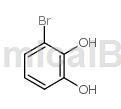Background and overview[1][2]
The density of 3-bromocatechol is 1.844 g/cm3, the melting point is 164-166ºC, the boiling point is 242.6ºC at 760 mmHg, the flash point is 100.5ºC, the refractive index is 1.657, and the vapor pressure is 0.0216mmHg at 25°C. 3-Bromocatechol can be used as an intermediate for pharmaceutical and chemical synthesis. If 3-bromocatechol is inhaled, please move the patient to fresh air; if there is skin contact, take off contaminated clothing, rinse the skin thoroughly with soap and water, and seek medical treatment if you feel uncomfortable; if there is eye contact, , you should separate your eyelids, rinse with running water or saline, and seek medical attention immediately; if ingested, rinse your mouth immediately, do not induce vomiting, and seek medical attention immediately.
Structure

Preparation[1]
3-Bromocatechol was prepared as follows: To 2,3-dimethoxy-bromobenzene (8.2g, 0.45 mol) in 50 mL of toluene was added AlCl 3 (22.1 g, 0.178 mol). The reaction mixture was refluxed for 3 hours, cooled, poured into 800 mL of water, and extracted with 800 mL of diethyl ether. The ether extract was dried over magnesium sulfate, filtered, and the solvent was removed under reduced pressure. The residue was chromatographed on silica gel, eluted with dichloromethane, the fractions were combined and evaporated under reduced pressure to obtain 3-bromocatechol (6.1 g, 73% yield).
Application
Can be used to prepare 2,3-methylenedioxybromobenzene: To 3-bromocatechol (3.0g, 0.16mol), KF (4.63g, 0.080mol), DMF (15mL, add CH2Br2 ( 4.13g, 0.024mol)) The suspension was heated to 135°C. 3 hours, cool and filter. Pour the filtrate into 200 ml of diethyl ether and wash with water, 1N KOH and brine. The organic layer was dried over magnesium sulfate, filtered, and the solvent was removed in vacuo to obtain 2,3-methylenedioxybromobenzene (1.45 g, 45% yield).
Main reference materials
[1] (US6342504) Aromatic heterocyclic derivatives as enzyme inhibitors



 微信扫一扫打赏
微信扫一扫打赏
